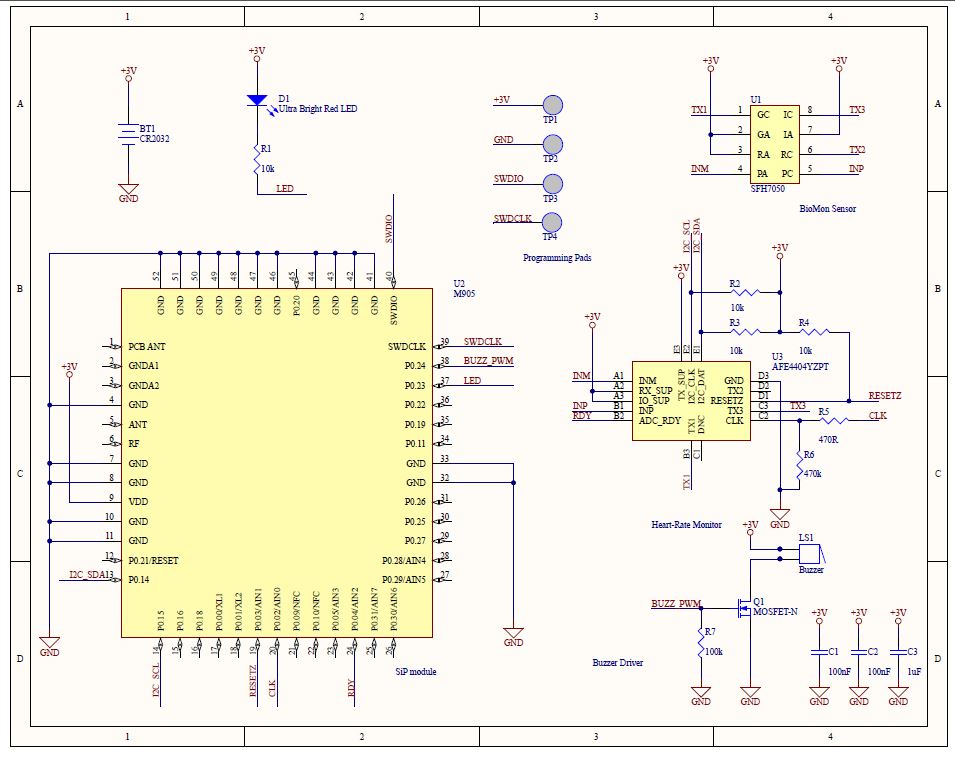When it comes to swimming there are numerous situations when a swimmer can be in danger. It can happen either in a swimming pool or in open waters (e.g. sea or lake). While being in motion our heart rate could increase to a very high level which can be unsafe for a person in water. Other dangerous situation could happen in a sea where can show up an external threat like for instance a shark. Another important way to detect if the swimmer is facing problems with breathing is to measure level of oxygen in blood. In above situations both users and rescue team need to be notified as soon as possible. Since the TIME is CRUCIAL. Thanks to the AFE4404 I would like to propose an idea as follows:
How does it work?The solution is based on the AFE4404 bio-sensor combined with BLE 5.0 technology. The idea of the design is to have it able to attach to an earlobe. Before getting into the water swimmer establish BLE connection between the module( wear in the similar way like hearing aid ) and our smartphone. After that we can enable the device and verify if the readings are correct. If we use dedicated app this information could be shared with the lifeguard team which can register that new device (swimmer is present). From this moment the module monitors heart-rate and amount of oxygen in blood. The threshold values of mentioned parameters can be set up separately through the mobile application. We can consider following use cases.
- First are health parameters. If they are exceeding previously set up levels the device sends an audible sign (since it is on the ear) for the user that wears it. Since we are using the BLE 5.0 we can gain from the fact that it supports MESH. It means that our device will broadcast an alarm message. Any other swimmers who are near by could get a specific ("beep" alarm) which means that someone needs help. This could improve "Time-to-Help". BLE 5.0 also supports extended range of the standard BLE up to around 1km (i.e. CC2640R2F - device supports this range) which should be more than enough to send the alarm to lifeguard as well.
- The second case is when an external threat can be in place. A life guard noticed that in a sea near people there is a shark or other danger. Thanks to a mesh capability of a BLE module it can broadcast message to all of the users who wear the device and can warn them beforehand.
Mounting on ear allows us to measure the heart rate and oxygen level easily. I.e See pic below:
- Since the head is mostly above the water surface we can keep the BLE connection relatively stable (needs to be checked if external antenna is needed)
- Easy to pass the an audio message to ear (beeps, etc.)
- Light weight
- BLE is very well established wireless standard in smartphones so it is easy to create an interface for swimmers.
- Easy to make a hermetic head to measure the bio-signals using the AFE4404
For prototyping I decided to use Thingy 52 IoT Sensor Kit from Nordic Semiconductor + Heart Rate 3 click board from MikroElektronika. The reason why I picked those devices is are follow:
Thingy board contains all other necessary components which was described in the project proposal block diagram:
The reason why I have picked the Thingy52 is also the fact that I have found a potential great SiP using the same nRF52832 device like on Thingy. So once the the solution will be verified from the functionality stand point using pair Thingy52 and Heart Rate 3 Click, we can move the software to the final application with big chance that everything will behave as on the prototype. Saying that I am able to propose the final schematic which allow to address the project requests: Cost effectiveness, time to market, flexibility to re-use the Mesh technology and available source code. The SiP module which I am thinking to use is the one from MtM + Technology M905 device ( https://www.mtmtech.com.tw/M905.html ). This is already certified BLE module with all necessary block to support this project.
Used components are reduced to minimum in order to keep the cost low.
Application:Optical sensor could be mounted on one side of the ear lobe, and the module and sensor will be mounted on other side. Together they can create some form of the "clip" which could looks like a earring. PCB board could be done in this following way ( see Fig.6 )
The Buzzer could be mounted inside the ear, or exchange to small vibration motor activated when the Oxygen level or heart rate exceed the safe thresholds.
Due to the fact that BLE or WiFi signal operate on 2.4GHz frequency the change to lost signal while the module and antenna is below the surface is high. However only when the situation is critical the BLE module start to broadcast message that the help is needed. At this point of time I am assume that the swimmer try to keep head above the surface where the antenna is located.
Software:Due to the fact that I am not expert is software I am still working on solution final solution :-(.
Summary:I need to work on software using Thingy52 and Module from MikroElektronika to build all the functionality described.
When the functionality will be confirmed I can estimate the power consumption of the system and adjust the battery, and adjust if the non-chargeable battery will be enough to keep alive device for reasonable time or not. If not then small charger need to be done ( similar to the one founded in Thingy52 )
- Everything need to be hermetic due to the contact with water.
- It also need to use elements like for example Styrofoam in order to not lost while use it.
- Cost is an important factor so the electronics need to be inexpensive which allow to push the cost on the good mechanical design.
I just recently founded that there solution like ( http://www.danbuoy.com/ ). Maybe if this buoy could be equipped with BLE and spread in the area where swimmers are race/train etc.. it could based on the distance from the swimmer open if help needed and allow him/her to reach this buoy and wait until rescue will came.
BLE signal in contact with water, maybe the position of the device need to be changed or we need to pick the module which allow to use external antenna.












Comments
Please log in or sign up to comment.